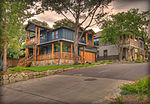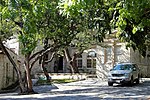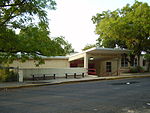South Congress

South Congress (abbreviated SoCo) is a neighborhood located on South Congress Avenue in Austin, Texas, United States. It is also a nationally known shopping and cultural district known for its many eclectic small retailers, restaurants, music and art venues and, more recently, food trucks.South Congress begins at the Colorado River and Ann W. Richards Congress Avenue Bridge and runs due south towards Ben White Boulevard/TX-71. The area is bordered by two historic South Austin neighborhoods: Travis Heights to the east and Bouldin Creek to the west.Since its humble beginnings in the 1850s, South Congress Avenue has been transformed from a rural country road to the capital city gateway and, finally, to the shopping district that it is today. Some Austinites attribute its enduring popularity to the unobstructed view of the Texas State Capitol.
Excerpt from the Wikipedia article South Congress (License: CC BY-SA 3.0, Authors, Images).South Congress
West Gibson Street, Austin
Geographical coordinates (GPS) Address Nearby Places Show on map
Geographical coordinates (GPS)
| Latitude | Longitude |
|---|---|
| N 30.25 ° | E -97.75 ° |
Address
Perla's
West Gibson Street
78704 Austin
Texas, United States
Open on Google Maps








